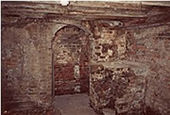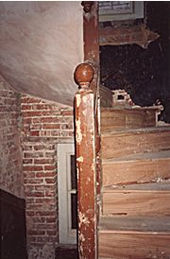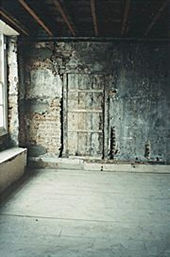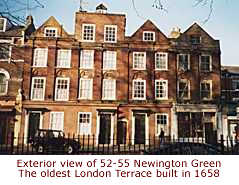|

A view of the basement
room at No 53 with
the original 17th
century corner feature

Interior view of No 53,
original 17th century
staircase

Interior view of No 53,
original 17th century
strap hinged door
|
Cromwellian Britain - Islington,
London
Islington is just under six square miles and is one of
the smallest of the thirteen inner London boroughs. It is situated on
the north side of the Thames, surrounded by Stoke Newington, Camden,
Hackney, Haringey and the City.

In the Anglo-Saxon charter of AD 1000 it is referred to as ‘Gislandune’
and later in the Domesday Book as ‘Isendone’ and ‘Iseldone’, which
probably means the lower town or fort. It was made up of four manors –
Barnsbury, Canonbury, Prebend and Highbury. There is evidence that
prehistoric man had settlements in the area, and the Romans had a summer
camp in Highbury. For a time it was believed that the main Roman road
from London to the north (Ermine Street) was situated along Highbury
Grove, Highbury Park and part of Blackstock Road. This, however, has
been disproved through archaeological research and there is a strong
belief that Kingsland Road, Stoke Newington Road and Stamford Hill in
the borough of Hackney are the site.
Several of the major roads running through Islington were important
routes out of London originating as early as the twelfth and thirteenth
centuries. By the seventeenth century all the roads were in a state of
disrepair and, as they were a vital link for the City, the Company of
Clothworkers gave money annually for their repair; gradually a series of
turnpikes were set up. In 1756 the New Road was built, later to become
Marylebone, Euston and Pentonville Roads. It was a forty feet wide road,
the earliest by-pass linking Paddington Green and Islington (north-west
London) to the City.
Islington has been a popular site for country houses because of its
close location to the City of London; Sir Walter Raleigh, the Earl of
Leicester and the Earl of Essex all had residences here. During the
seventeenth century Clerkenwell Green was a popular location for the
nobles and affluent. Izaak Walton lived just off the Green and it was
here that he wrote his famous book The Compleat Angler published in
1653. Nearby in Charterhouse Square lived Catherine Parr, Richard Baxter
and William Davenant; references to Islington and Finsbury can be found
in Davenant's poetry.
It was the dairy district for supplying the City and it was also the
route for over 300,000 animals passing through the Islington turnpike on
their way to Smithfield for sale and slaughter. The inns were popular
with the drovers and stagecoaches; there are still many inns and pubs in
Upper Street and Essex Road today. It was an area where Dick Turpin used
to ply his trade and then use the back lanes of Holloway and Islington
as a means of escape. In Upper Holloway the well-known coaching inn The
Crown marks the site of an old house where Oliver Cromwell supposedly
stayed.
One of the oldest surviving buildings in Islington is Canonbury Tower,
built sometime between 1509 and 1532. In 1253 Ralph de Berners granted
the lands and rents to the Canons of St Bartholomew’s Priory; it was
excellent dairy land and not far from their priory. But it was not until
William Bolton, Henry VIII’s Master of Works for the chapel in
Westminster Abbey, became the Prior that the land was built on. He
decided to build himself a mansion with a tower to take advantage of the
view. Two properties nearby at no. 6 Canonbury Place and no. 4 Alwyne
Villas still display Bolton’s Rebus of a bolt (arrow) passing through a
tun (barrel). The work was completed in the same year as Bolton’s death,
1532.
In 1535 Thomas Cromwell took up residence at Canonbury Tower and from
this location organised the dissolution of the monasteries and their
transfer into royal ownership. In 1539 on the completion of the
dissolution, Henry VIII gave the Canonbury Manor to Cromwell, presumably
as a thank you for the £900,000 a year Henry had made out of the
transfers. Sadly Cromwell was only to live there another year, for he
was executed on trumped up charges of treason in 1540. Henry then used
money from the Manor to pay Anne of Cleves’s divorce settlement.
In 1547 it was given to John Dudley, Earl of Warwick, by Edward VI.
Dudley later became Earl of Northumberland and, after successfully
overthrowing Somerset, he virtually ruled due to Edward’s ill health. He
persuaded the king to name his cousin, Lady Jane Grey, as his successor;
the fact that she had been married off to Dudley’s fourth son was
important to Dudley’s plans. He was executed in 1553 and the following
year his son and daughter-in-law joined him.
In 1594 it became the property of Sir John Spencer, Lord Mayor of
London, and later passed to his son-in-law, the Earl of Northampton. The
Northamptons leased the property out for various uses including rented
accommodation; Sir Francis Bacon, Arthur Onslow (Speaker of House of
Commons), Oliver Goldsmith and Washington Irving have all lived there.
In 1952 it became the residence of the Tavistock Repertory Company and
is now known as the Tower Theatre.
Sir Hugh Myddleton, a Welsh goldsmith and philanthropist, was
responsible for bringing London its first clean water supplies. The four
thousand members of the Company of Water-Tankard Bearers protested
against the scheme, fearing it would put them out of business.
Nevertheless, the scheme went ahead in 1609. Myddelton together with
twenty-eight merchant adventurers built a canal from the Hertfordshire
rivers of Chadwell and Amwell, forty miles to the New River Head
reservoir at Amwell Street in Clerkenwell.
The project bankrupted Myddelton and as the canal passed through the
grounds of Theobalds Palace, James I helped him by paying for half and
in return received half of the profits. It was completed in 1613. The
second phase of the scheme was to distribute the water from the
Islington reservoir to the households in the City. Hollowed out elm
trunks were used with a life expectancy of between four and seven years;
therefore the project needed high maintenance. There was no water
pressure and the supply was inconsistent so only ground floor premises
were supplied at a quarterly rental of 5s or 6s 8d. There was a concern
about the freshness of the water; customers and profits were slow to
materialise. In 1631 Charles I sold his shares in despair. Eventually
after improvements, such as a windmill to pump water from the reservoir
and replacing the elm trunks with iron, it proved to be a success.
The New River Company later became part of the Metropolitan Water Board
and it was not until 1990 that the New River stopped supplying North
London and was replaced by deep mains. The river flowed down the centre
of the present day Petherton Road; in 1946 the supply was terminated at
Stoke Newington and Petherton Road was filled in and in more recent
years grassed over. Part of the New River can still be seen off
Canonbury Road and it is now an ornamental walk.
Islington has been famous for its springs and spas. Thomas Sadler’s well
was advertised by building a ‘Musick house’ in 1683. After a series of
theatres and music halls were created on the site, eventually Lilian
Baylis raised funds and commissioned a theatre in 1931 which became
famous for creating the Royal Ballet and the Royal Opera Company.
The Charterhouse Monastery used the spring at Clerkenwell and later in
1641 it was enclosed with an arched structure of flint and brick known
as White Conduit. It was much later, in 1730, that a pleasure gardens
and tearooms opened called the White Conduit; this resort was patronised
by the genteel together with their servants into the 1820s. It provided
entertainment such as balloon flights, fireworks, singing and dancing.
It had a cricket ground where Thomas Lord, of Lord’s cricket ground
fame, was groundsman. This was why during the seventeenth and eighteenth
centuries Islington was considered an invigorating pleasure resort.
During the civil war in 1643 the Common Council passed an act for the
defence of the City; this was to take the form of a line of redoubts and
fortifications. In reality the fortifications were simply small redoubts
and bastions at certain fixed points. At Islington’s windmill a battery
and breastwork and at the Pound a small redoubt were positioned.
During the Great Plague and fire Islington again played its part as a
safe haven for those in peril. John Evelyn writes in his diary on 7
September 1666 about visiting the City and seeing the damage caused by
the fire. He goes on to say:
‘I then went towards Islington and Highgate, where one might have seen
200,000 people of all ranks and degrees dispersed, and lying along by
their heaps of what they could save from the fire, deploring their loss;
and, though ready to perish for hunger and destitution, yet not asking
one penny for relief, which to me appeared a stranger sight than any I
had yet beheld...’
The extent of the damage and the plight of the people obviously moved
him and on 13 September 1666 he presented Charles II with a survey of
the ruins and a scheme for the re-building of the City.
Islington has become an important location over the centuries for
writers, religious and political dissenters and refugees. Thomas Paine
lodged at the Angel Inn and wrote Rights of Man while living in
Clerkenwell. Mazzini, Garibaldi, Lenin, Trotsky, and Stalin all lived
and worked in the area.
Bunhill Fields were first used as the dissenters burial ground in 1665
and by the time it closed in 1852 it had received over 12,000 bodies.
Several famous people are buried there – Daniel Defoe, William Blake,
John Bunyan, Susannah Wesley mother of Samuel, John and Charles Wesley,
as well as some of Oliver Cromwell’s descendants.
Bunhill Row, which was originally Artillery Walk, was where John Milton
finished Paradise Regained; he lived there from 1663 until his death in
1674 and is buried in St Giles Cripplegate beside his father.
In May 1654 Peter Vowell, a schoolmaster from Islington, was arrested
for his part in Henshaw and Gerard’s scheme to assassinate Oliver
Cromwell. Vowell was supposedly to provide arms and help seize the
troopers’ horses while they grazed in Islington fields. Luckily the
Council received intelligence of the plot and arrests were made. After
questioning and in-depth inquiries, three of those arrested were
selected for trial. On 30 June they were found guilty of treason and on
10 July Gerard was beheaded at the Tower and Vowell hanged at Charing
Cross. Fox was transported to Barbados the following year as he
confessed. The investigation of the plot led to the Catholics being
blamed and hostility towards France. An angry Cromwell ordered Baas to
leave the country for his alleged part in stirring up trouble to incite
a rebellion and assassination.
Newington Green has had quite a chequered history. During the fifteenth
century there were prosperous Londoners owning copyhold property (land
tenure where the owner had a copy of the record entered in the manorial
role). In the sixteenth century Henry Percy, Earl of Northumberland (Ann
Boleyn’s boyfriend before she married Henry VIII) had a house on the
north side of the Green (which is now part of Stoke Newington). This was
Brook House but known as the Bishop’s Palace up until the eighteenth
century when it was tenements for the poor. This property together with
a house on the south side were used by Henry VIII as a resort for
hunting wild boars, stags and wild bulls which were plentiful in the
surrounding forest. Today there are several streets near here with names
such as King Henry’s Walk, Boleyn Road (formally Ann Boleyn’s Walk) and
Queen Elizabeth’s Walk.
Sir Henry Mildmay served as MP for Maldon in Essex during the Short and
Long Parliaments and was Master of the Jewel House for Charles I. His
grandfather, Sir Walter Mildmay, had been Chancellor of the Exchequer
for Elizabeth I and founder of Emmanuel College, Cambridge, where Henry
had been educated. Henry married Ann Haliday, daughter and heiress of
Alderman William Haliday, who had a house and forty-four acres of land
on the south side of Newington Green. Mildmay served as a member of the
Council of State from 1649 until 1652 and was Revenue Commissioner from
1645 until 1652. In 1648 he took part in the trial of Captain Burley,
and in 1649 he was one of the judges at the trial of Charles I, but he
declined to sign the death warrant. He was one of the Councillors
responsible for the inventory and appraisal of the personal effects of
the King, Queen and the Prince of Wales. His brother, Anthony Mildmay,
Gentleman Usher and Carver to the king, conveyed the body of Charles I
to Windsor and was responsible for Henry, Duke of Gloucester and
Princess Elizabeth at Carisbrooke while they awaited their departure
abroad. In 1661, on the anniversary of Charles I’s execution, Sir Henry
Mildmay together with Munson and Wallop were transported to Tyburn on
sledges as a humiliation. As they had been spared under the Act of
Indemnity, they were then taken back to the Tower and confined there;
Mildmay died in 1664. There are now several thoroughfares on the
Haliday’s property named after Mildmay.
Newington Green became the home of non-conformists during the
seventeenth century and the centre for non-conformist education. One of
these academies, Charles Morton’s, educated Daniel Defoe and Samuel
Wesley. Samuel Wesley was the father of Samuel, John and Charles Wesley
and son-in-law of Dr Samuel Annesley, vicar of St Giles Cripplegate. He
had been appointed to the living by Lord Protector Richard Cromwell, but
had to leave the living in 1662 because of the Act of Uniformity.
On 11 April 1691 Mary Cromwell, great grand-daughter of Oliver Cromwell,
was born at Newington Green; she died unmarried in 1731 and is buried in
Bunhill Fields.
In 1708 the Unitarian chapel was built on the north side of the Green
and was later enlarged in 1860. It had some very prominent members and
ministers, including Minister Godwin, philosopher and political
economist, whose wife, Mary Wollstonecraft, was a feminist writer who
ran a girls school there. Their daughter was Mary Wollstonecraft
Shelley, the writer of Frankenstein. In 1839 Thomas Cromwell became
Minister and served until 1864; he was a descendant of Oliver Cromwell.
Before becoming a Minister he had worked in the literary department at
Longmans the publishers. He was a writer and among his works are 'Walks
Through Islington' (1835), a play which was produced twice at Drury
Lane, and Oliver Cromwell and his Times, which ran to eight volumes
(1821, 2nd edition 1822).
The oldest terrace in London is situated at numbers 52-55 Newington
Green. It dates from 1658; this date is cut into the brickwork of number
54. It is amazing that it has survived considering the amount of V2
devastation in the area during World War II. At some point in their
history, these terraced properties were converted to shops and in recent
years English Heritage has advised on the work to transform numbers
53-55 back as houses. The leases were sold and they now are private
residences again. Sadly number 52 is in a very poor state and trading as
a shoe repair shop.
By Jane Mills
|
